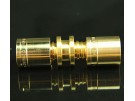Industry News
Use in musical instruments
Views: 1875 Update Date:Apr 01 , 2019
The high malleability and workability, relatively good resistance to corrosion, and traditionally attributed acoustic properties of brass, have made it the usual metal of choice for construction of musical instruments whose acoustic resonators consist of long, relatively narrow tubing, often folded or coiled for compactness; silver and its alloys, and even gold, have been used for the same reasons, but brass is the most economical choice. Collectively known as brass instruments, these include the trombone, tuba, trumpet, cornet, baritone horn, euphonium, tenor horn, and French horn, and many other "horns", many in variously-sized families, such as the saxhorns. Other wind instruments may be constructed of brass or other metals, and indeed most modern student-model flutes and piccolos are made of some variety of brass, usually a cupronickel alloy similar to nickel silver/German silver. Clarinets, especially low clarinets such as the contrabass and subcontrabass, are sometimes made of metal because of limited supplies of the dense, fine-grained tropical hardwoods traditionally preferred for smaller woodwinds. For the same reason, some low clarinets, bassoons and contrabassoons feature a hybrid construction, with long, straight sections of wood, and curved joints, neck, and/or bell of metal. The use of metal also avoids the risks of exposing wooden instruments to changes in temperature or humidity, which can cause sudden cracking. Even though the saxophones and sarrusaphones are classified as woodwind instruments, they are normally made of brass for similar reasons, and because their wide, conical bores and thin-walled bodies are more easily and efficiently made by forming sheet metal than by machining wood.
The keywork of most modern woodwinds, including wooden-bodied instruments, is also usually made of an alloy such as Nickel Silver/German Silver. Such alloys are stiffer and more durable than the brass used to construct the instrument bodies, but still workable with simple hand tools -- a boon to quick repairs. The mouthpieces of both brass instruments and, less commonly, woodwind instruments are often made of brass among other metals as well.
Next to the brass instruments, the most notable use of brass in music is in various percussion instruments, most notably cymbals, gongs, and orchestral (tubular) bells (large "church" bells are normally made of bronze). Small handbells and "jingle bell" are also commonly made of brass.
The harmonica is a free reed aerophone, also often made from brass. In organ pipes of the reed family, brass strips (called tongues) are used as the reeds, which beat against the shallot (or beat "through" the shallot in the case of a "free" reed). Although not part of the brass section, snare drums are also sometimes made of brass. Some parts on electric guitars are also made from brass, especially inertia blocks on tremolo systems for its tonal properties, and for string nuts and saddles for both tonal properties and its low friction.
The keywork of most modern woodwinds, including wooden-bodied instruments, is also usually made of an alloy such as Nickel Silver/German Silver. Such alloys are stiffer and more durable than the brass used to construct the instrument bodies, but still workable with simple hand tools -- a boon to quick repairs. The mouthpieces of both brass instruments and, less commonly, woodwind instruments are often made of brass among other metals as well.
Next to the brass instruments, the most notable use of brass in music is in various percussion instruments, most notably cymbals, gongs, and orchestral (tubular) bells (large "church" bells are normally made of bronze). Small handbells and "jingle bell" are also commonly made of brass.
The harmonica is a free reed aerophone, also often made from brass. In organ pipes of the reed family, brass strips (called tongues) are used as the reeds, which beat against the shallot (or beat "through" the shallot in the case of a "free" reed). Although not part of the brass section, snare drums are also sometimes made of brass. Some parts on electric guitars are also made from brass, especially inertia blocks on tremolo systems for its tonal properties, and for string nuts and saddles for both tonal properties and its low friction.












